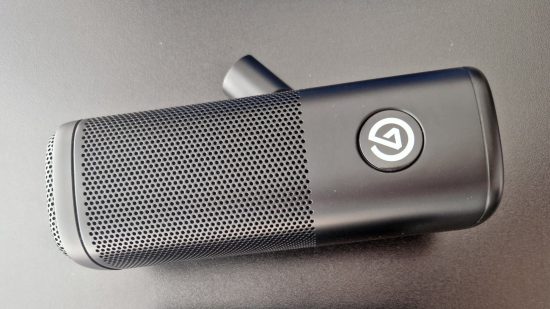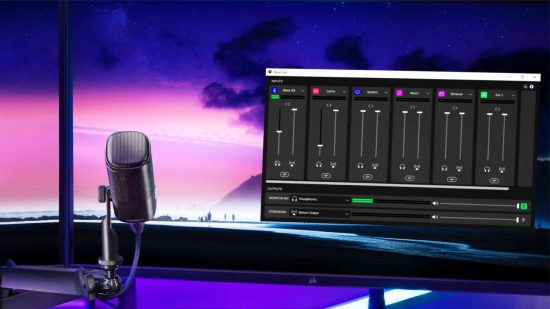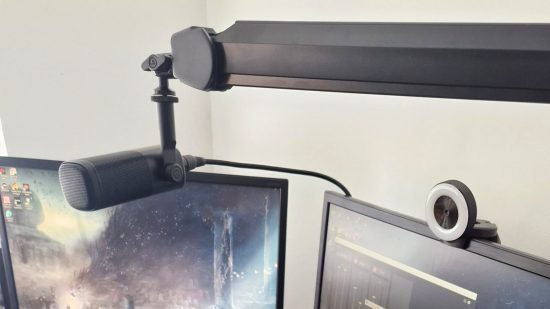To say that the Elgato Wave DX has some mighty shoes to fill is an understatement, considering the Elgato:Wave 3 has long been considered Corsair’s best streaming mic. Ditching USB in favor of an XLR cable, the new flagship isn’t as simple as it requires additional kit to run, but it raises the bar for streamers looking for the highest sound quality to deliver their sweet tones.
Elgato not only strives to make the best gaming microphone but has made a name for itself as within brand for professional streamers. It offers just about everything a content creator needs, from the best capture card to webcams and green screens. Even its Wave XLR preamp, for some reason, predates the new XLR dynamic mic.
It’s hard to talk about Elgato Wave DX without mentioning the Wave XLR audio interface and Wave Link software. XLR microphones require a preamp to work, and while you can use just about any interface, it’s immediately apparent that the Elgato Wave DX was designed with this particular device in mind.
It is well known that USB microphones have an advantage over XLR microphones in terms of convenience and portability. However, the Elgato Wave DX is about as plug-and-play as it gets. Setup is incredibly intuitive and doesn’t require the involvement of a sound engineer; To connect the Elgato Wave DX and Wave XLR to your PC, all you need to do is plug in a few cables and you’re good to go.
Design
The Elgato Wave DX features an angular design that’s a bit sleeker than others in the series, giving it a professional look that sets it apart from the competition. It’s also significantly heavier than entry-level broadcast microphones. it feels expensive to drive, it seems.
It’s also not the kind of mic that begs to be seen. It’s discreet enough not to draw attention to itself whether you choose to include it on your camera or not. The lack of a pop filter can be confusing at first, but I’m happy to report that the Elgato Wave DX includes a built-in pop filter, meaning you never have to worry about gaming with a bulky screen or watching. for a foam sleeve. .. which is convenient.
Unlike the Elgato Wave:3, the Elgato Wave DX does not come with its own stand. Includes 3/8″ and 5/8″ threaded adapters to connect to compatible mic stands, but if you don’t have an existing kit, these are additional costs to consider when purchasing.
The ideal Elgato Wave DX mount depends a lot on the type of content you’re creating. There’s an optional mini-stand that you can pair with the Elgato Wave DX, which is a great option for podcasting, but the tall bar ensures that it reduces impact vibration caused by the keyboard. Both mounting options are easily manipulated to suit your needs, but it’s worth mentioning that the stem is narrow and long enough to stretch comfortably over the monitor. The matte finish also detects fingerprints incredibly easily, which is a bit of a pain if you have to change settings regularly.
The Wave XLR audio interface serves as a companion to the Elgato Wave DX, but it’s also a discreet addition to your workstation. The interface features a single control wheel and LEDs that indicate input gain and output volume. Making audio adjustments from a workstation is a good alternative to moving sliders with the mouse, and the mute control is very responsive and activated with a light touch on the back of the Wave XLR.
Overall, the Elgato Wave DX, Boom Arm, and Wave XLR offer a professionally innocuous audio system, and if you like a sleek black workstation, these peripherals will feel right at home on your desk.

sound and performance
Operating at the recommended 45dB, the Elgato Wave DX is incredibly clear, and testing the upper limits of its input made me feel like a budding ASMR musician. Remember that the Elgato Wave DX is a dynamic microphone, so it is more than capable of operating without additional 48V phantom power.
Condenser mics are great for small soundproof offices, but if your broadcast setup is in your living room or common room, you can pretty much guarantee that any audio device will make it to your recording without the help of something like Nvidia Broadcast. . In contrast, the Elgato Wave DX can filter out as much background noise as needed with some Wave Link settings without affecting the quality of your voice. It’s especially good at minimizing banging and slamming or pet mischief.
The sound quality of an XLR microphone is certainly better than that of a standard USB microphone, but the type of sound produced by a dynamic microphone can sometimes be described as a bit flat compared to the richer tones of a condenser microphone. . This is also true for Elgato Wave DX, but I find it better suited for highlighting voice feedback in music, dialogue, and video game sound effects.
Elgato recommends a distance of 8-12cm for optimal voice pickup, which is less of a concern for those who prefer their microphone to be heard rather than seen during streaming. However, if there is a drop in sound quality when used at a distance of 18-20 cm, it is so insignificant that it is unnoticeable. In fact, you don’t have to worry about how far you are from the microphone, thanks to a very reasonable cardioid polar pattern that keeps your voice receptive even when you’re speaking on the other end.

software
The Elgato Wave Link software is an optional app for monitoring while streaming, but the minimalistic user interface keeps it compact and intuitive. Each audio source is represented by two simple faders, one for the monitor output and one for the stream output. Once you’ve balanced them correctly, you can link the two faders to control both volumes at the same time.
Juggling audio sources in OBS can be endlessly frustrating, but Wave Link allows you to easily adjust audio levels so that your microphone output is always above the audio source you’re playing with. You can even isolate your stream mix to hear exactly what your stream is listening to and troubleshoot audio problems affecting your viewers without relying on them to diagnose problems for you.
When combined with the Wave Link, the Elgato Wave DX can also take advantage of Clipguard, Lewitt’s anti-distortion technology designed specifically to prevent clipping or peaking. This is an incredibly useful feature that can be activated simply by checking a box, after which you can forget about it. However, running the Elgato Wave DX at the recommended level of 45dB showed no signs of gain reduction, even when used during high-intensity transmission.

Verdict
The Elgato Wave DX is a world away from budget broadcast mics like the Razer Seiren X and is a great option for anyone looking to switch to XLR broadcast mics. The mic only costs $99.99 / £109.99, which is a surprisingly good price compared to other dynamic XLR mics like the oddly popular Shure SM7B and its sound quality is undeniably top-notch.
However, if you’re not already equipped with a compatible arm mount and audio interface, you can expect to pay at least $289.99 / £309.99 for the full Elgato Wave DX. While this is certainly a steep price, it’s worth remembering that you’re not just getting a microphone, but a full audio package, plus access to the software that makes it work.
Ultimately, the Elgato Wave DX is a great choice for content creators looking to take audio quality to the next level. It conveniently bridges the gap between low-budget and ultra-pro, which doesn’t suit the average streamer. It’s a great first step into the world of dynamic XLR microphones, delivering voice clarity that’s far above the usual suspects sold to streamers.
Elgato Wave DX
A dynamic broadcast microphone with ultra-clear audio quality that will take your setup to a professional level without the big expense.
Source : PC Gamesn

